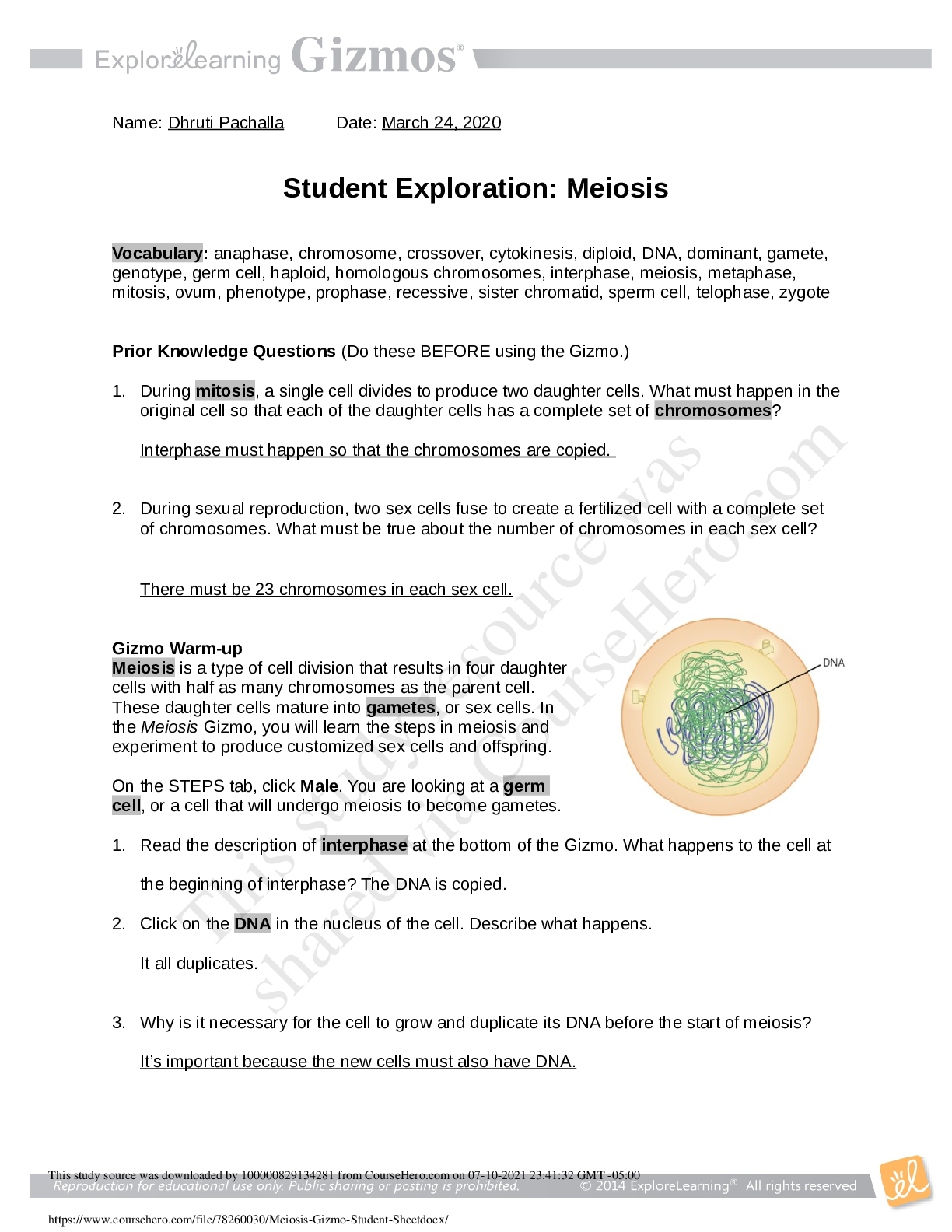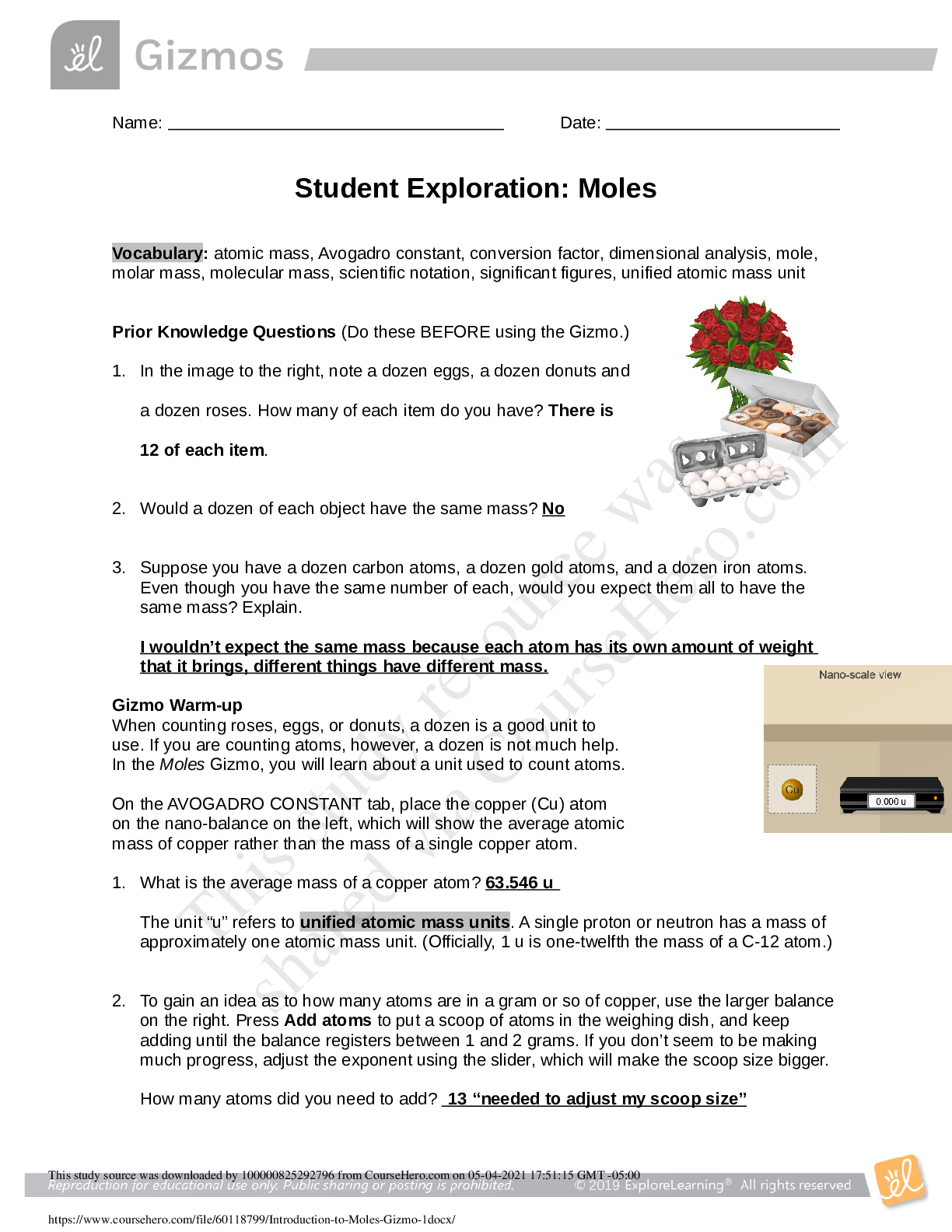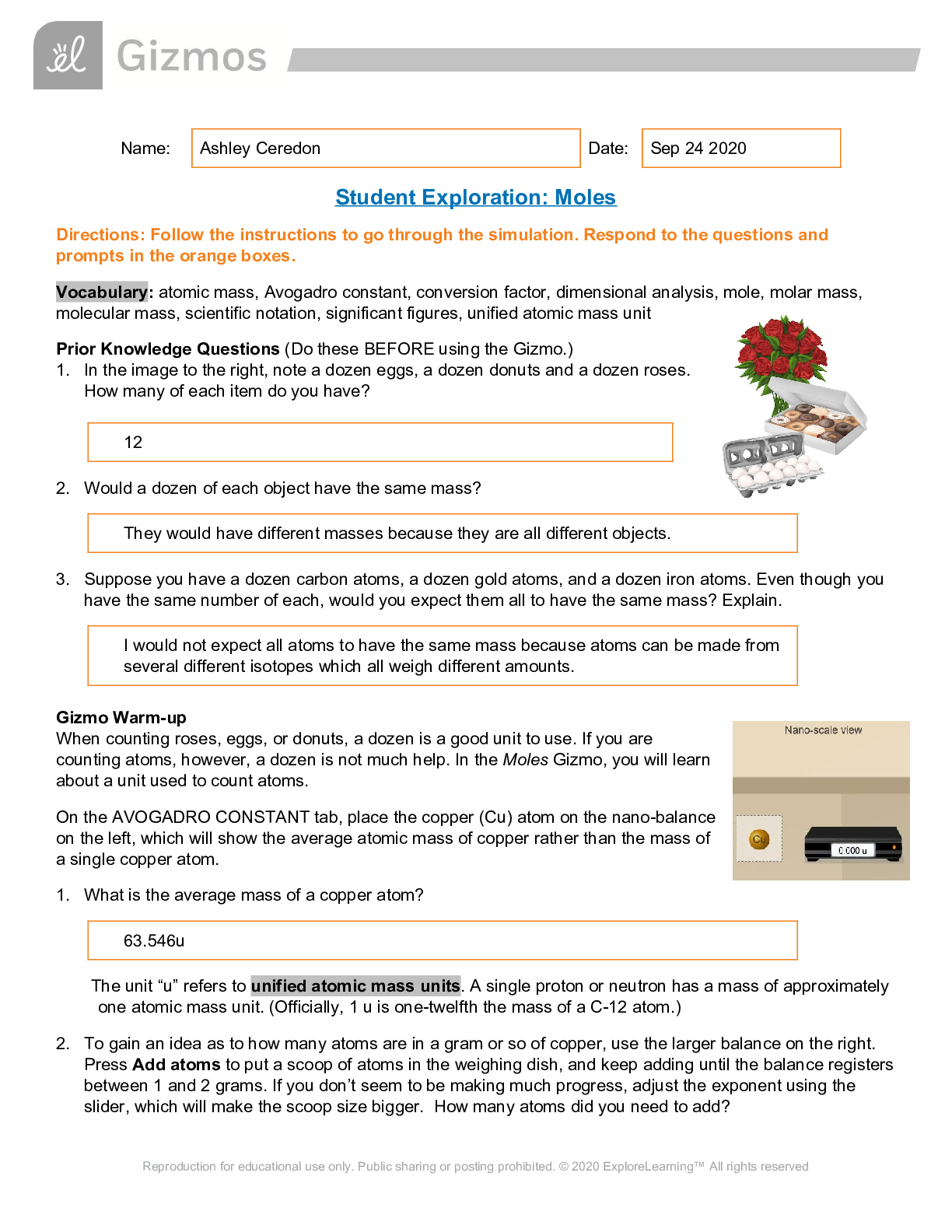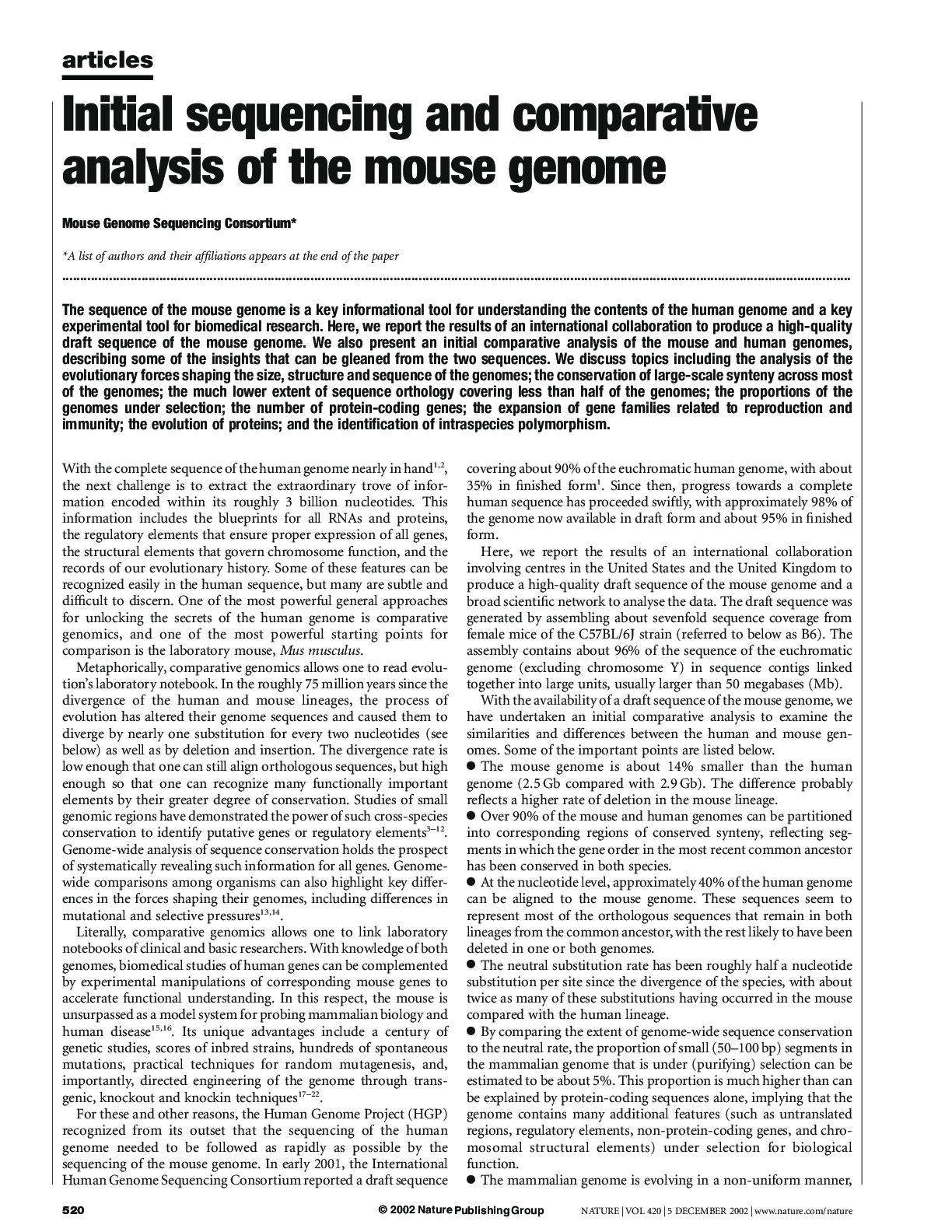Physics > GIZMOS > Feel the Heat Gizmo student Sheet[FULL QUESTIONS ANAD ANSWERS LISTED BELOW] AND DETAILS TO PASS EXAM (All)
Feel the Heat Gizmo student Sheet[FULL QUESTIONS ANAD ANSWERS LISTED BELOW] AND DETAILS TO PASS EXAMS
Document Content and Description Below
Answer Key Prior Knowledge Question (Do these BEFORE using the Gizmo.) Eduardo hurts his knee during a basketball game. The trainer applies a cold pack, which gets cold after being squeezed. The ne... xt day, Eduardo’s friend Beth is going sledding. Beth buys some hand warmers and puts them into her gloves. All morning, her hands stay toasty warm. 1. Where do you think the “cold” and the heat comes from? Gizmo Warm-up As you have probably seen with instant cold packs, hand warmers, and the MRE Flameless Ration Heater, some reactions absorb energy while others release it. In the Feel the Heat Gizmo, you will explore these energy changes while making your own new MRE Flameless Ration Heater. Below are the solids, and their names, to be tested that are in the blue lid bottles resting on the shelf in the upper right hand corner ● CaCl2 = Calcium Chloride (1st bottle) ● NaC2H3O2 = Sodium Acetate (2nd bottle) ● NH4NO3 = Ammonium Nitrate (3rd bottle) ● KCl = Potassium Chloride (4th bottle) ● NaCl = Sodium Chloride (5th bottle) ● NaBr = Sodium Bromide (6th bottle) To begin, drag a bottle of NaC2H3O2 (sodium acetate, the 2nd bottle) from the shelf to the ‘Drag container of powder here’ spot directly below.. Using the sliders for Water Volume (mL) and Powder Mass (g) on the bottom right of the screen, select 100 mL for the water and 20 g of powder to add. Note the beginning temperature, and then press Play ( ) located in the bottom left of the screen to see what happens to the temperature, measured in Celsius (ºC). Click the reset button ( ) 2. Experiment with different powders by clicking and dragging the one on the table back to the shelf and then dragging a new container down to the ‘Drag container of powder here spot’ until you find one that produces the opposite effect on the temperature. Reproduction for educational use only. Public sharing or posting prohibited. © 2020 ExploreLearning™ All rights reserved The “cold” comes from an endothermic reaction, bonds are being broken allowing energy to be absorbed causing something to become cold or cook. the heat comes from an exothermic 1. Did the temperature go up or down? UpWhen a powder dissolves in water a solution is formed. The powder is the solute and the water is the solvent. Oftentimes energy changes accompany the formation of a solution. When added to water, some powders cause the resulting solution to get hot, while others make it cold. Some powders don’t produce a temperature change at all. When energy changes do occur, they can be put to good use. Introduction: The reactions in this activity are performed within a calorimeter, an insulated device that keeps heat from escaping, enabling you to accurately record temperature changes. Question: Why does the temperature change when a powder is dissolved in water? 1. Get the Gizmo ready: Drag a bottle of NaC2H3O2 (the 2nd bottle) from the shelf. Set the Water volume to 100mL and the Powder mass to 20 g. 2. Observe: In between the hot plate where you read the temperature and the ‘Drag container of powder here’ spot click to check and turn on “Show molecular view”, and notice the water molecules. a. What color line represents the bonds between the water molecules? 3. Make sure the Water volume is set to 100 mL and the Powder mass to 20 g, and then click Play. Click Pause ( ) after adding the powder. You should now see some NaC2H3O2 (sodium acetate) in the water. A. You should see some new small lines stemming off the purple part of the NaC2H3O2 that represent the bonds in this compound. What color represents the bonds between the particles of NaC2H3O2? B. Click Play. Watch the animation a few times. What happens to the NaC2H3O2 bonds (the orange lines)? C. What happens to the bonds (thin light blue lines) between water molecules? Reproduction for educational use only. Public sharing or posting prohibited. © 2020 ExploreLearning™ All rights reserved What powder did you use? NH4NO3 = Ammonium Nitrate (3rd bottle) makes it colder 12 celsius Activity A: Molecular view The thin light blue lines orange lines they vanished because An exothermic reaction is occurring which means more energy is released when the bonds are formed in the products than used to break the bonds in the reactant causing an increase in temperature. Increased Strong bonds are form than the one’s absorbed to break the weak bondsD. Watch until the reaction runs its course and pauses. What line color are the new bonds that form between the NaC2H3O2 and water? 4. Investigate: In the animation, the purple arrows represent energy that is being absorbed from the water, while the orange arrows show energy that is being released into the solution. 5. Replay the animation, carefully noting the purple arrows. What does this absorbed energy (i.e. purple arrows) do? 6. Now replay the animation but focus on the orange arrows. What occurs to the temperature every time an orange arrow is released? 7. Fill in the blanks: Pause and answer the question in the peardeck. 8. Based on the arrow sizes (purple vs. orange), do you think more energy is absorbed in breaking bonds (purple arrow), or is more energy released when new bonds form (orange arrows)? 9. Which bonds do you think are stronger, the bonds that are broken or the bonds that are formed? Explain your reasoning. Reproduction for educational use only. Public sharing or posting prohibited. © 2020 ExploreLearning™ All rights reserved Red They break When the orange lines are released a strong bond is formed and a weak bond is broken, but When this process happens the temperature goes up a little bit so energy is being released. the heat increases when orange line appear When bonds are broken, energy is Absorbed,this process is endothermic When new bonds form, energy is Released,this process is called exothermic more energy is being released when a new bond is formed (orange arrows)10. Infer: Drag a bottle of KCl (4th bottle) from the shelf. Add 20 g of this solid to 100 mL of water. Click Play and look once again at the molecular vie [Show More]
Last updated: 2 years ago
Preview 1 out of 9 pages
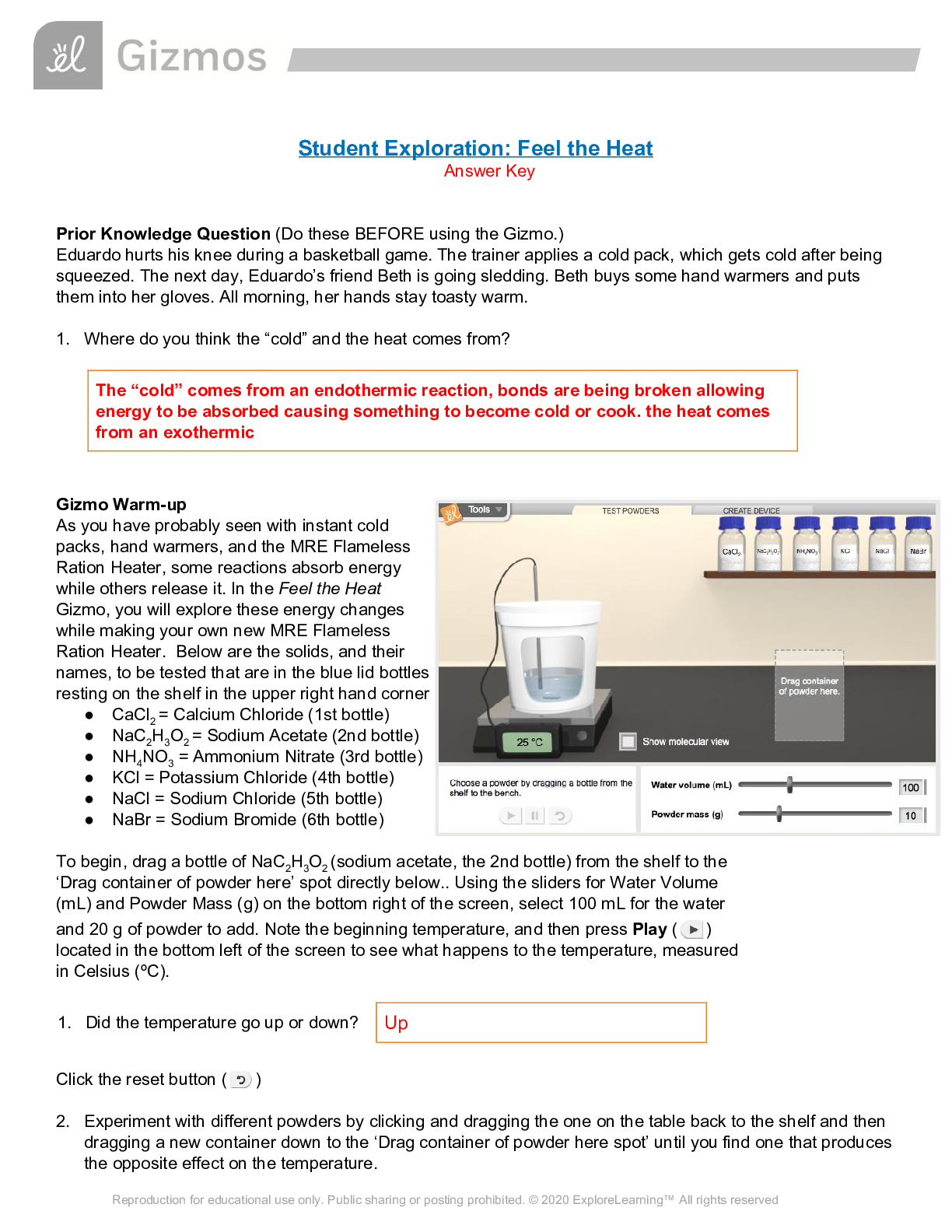
Buy this document to get the full access instantly
Instant Download Access after purchase
Buy NowInstant download
We Accept:

Reviews( 0 )
$12.00
Can't find what you want? Try our AI powered Search
Document information
Connected school, study & course
About the document
Uploaded On
Apr 26, 2021
Number of pages
9
Written in
Additional information
This document has been written for:
Uploaded
Apr 26, 2021
Downloads
0
Views
309

